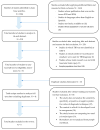Blood Biomarkers as Optimization Tools for Computed Tomography in Mild Traumatic Brain Injury Management in Emergency Departments: A Systematic Review
- PMID: 40863412
- PMCID: PMC12387816
- DOI: 10.3390/jpm15080350
Blood Biomarkers as Optimization Tools for Computed Tomography in Mild Traumatic Brain Injury Management in Emergency Departments: A Systematic Review
Abstract
Background/Objectives: Traumatic brain injury (TBI), especially mild TBI (mTBI), is frequently caused by traffic accidents, falls, or sports injuries. Although computed tomography (CT) is the gold standard for diagnosis, overuse can lead to unnecessary radiation exposure, increased healthcare costs, and emergency department saturation. Blood-based biomarkers have emerged as potential tools to optimize CT scan use. This systematic review aims to evaluate recent evidence on the role of specific blood biomarkers in guiding CT decisions in patients with mTBI. Methods: A systematic search was conducted in the PubMed, Cochrane, and CINAHL databases for studies published between 2020 and 2024. Inclusion criteria focused on adult patients with mTBI evaluated using both CT imaging and at least one of the following biomarkers: glial fibrillary acidic protein (GFAP), ubiquitin carboxy-terminal hydrolase L1 (UCH-L1), and S100 calcium-binding protein B (S100B). After screening, six studies were included in the final review. Results: All included studies reported high sensitivity and negative predictive value for the selected biomarkers in detecting clinically relevant intracranial lesions. GFAP and UCH-L1, particularly in combination, consistently identified low-risk patients who could potentially forgo CT scans. While S100B also showed high sensitivity, discrepancies in cutoff values across studies highlighted the need for harmonization. Conclusions: Blood biomarkers such as GFAP, UCH-L1, and S100B demonstrate strong potential to reduce unnecessary CT imaging in mTBI by identifying patients at low risk of significant brain injury. Future research should focus on standardizing biomarker thresholds and validating protocols to support their integration into clinical practice guidelines.
Keywords: S100 calcium binding protein beta subunit; X-Ray computed; biomarkers; glial fibrillary acidic protein; mild traumatic brain injury; sensitivity and specificity; tomography; ubiquitin thiolesterase.
Conflict of interest statement
The authors declare no conflicts of interest.
Figures
Similar articles
-
S100B, GFAP, UCH-L1 and NSE as predictors of abnormalities on CT imaging following mild traumatic brain injury: a systematic review and meta-analysis of diagnostic test accuracy.Neurosurg Rev. 2022 Apr;45(2):1171-1193. doi: 10.1007/s10143-021-01678-z. Epub 2021 Oct 28. Neurosurg Rev. 2022. PMID: 34709508
-
Predictive Value of Nervous Cell Injury Biomarkers in Moderate-to-Severe Traumatic Brain Injury: A Network Meta-Analysis.Neurology. 2025 Sep 9;105(5):e213997. doi: 10.1212/WNL.0000000000213997. Epub 2025 Aug 14. Neurology. 2025. PMID: 40811753
-
Accuracy of GFAP and UCH-L1 in predicting brain abnormalities on CT scans after mild traumatic brain injury: a systematic review and meta-analysis.Eur J Trauma Emerg Surg. 2025 Jan 24;51(1):68. doi: 10.1007/s00068-024-02697-3. Eur J Trauma Emerg Surg. 2025. PMID: 39856327
-
The Diagnostic and Prognostic Role of Biomarkers in Mild Traumatic Brain Injury: An Umbrella Meta-Analysis.Brain Sci. 2025 May 28;15(6):581. doi: 10.3390/brainsci15060581. Brain Sci. 2025. PMID: 40563753 Free PMC article. Review.
-
Exclusion of intracranial lesions in mild traumatic brain injury using glial fibrillary acidic protein and ubiquitin C-terminal hydrolase-L1: a European multicenter study.Eur J Emerg Med. 2025 Oct 1;32(5):351-358. doi: 10.1097/MEJ.0000000000001234. Epub 2025 Apr 9. Eur J Emerg Med. 2025. PMID: 40214300
References
Publication types
LinkOut - more resources
Full Text Sources
Miscellaneous


